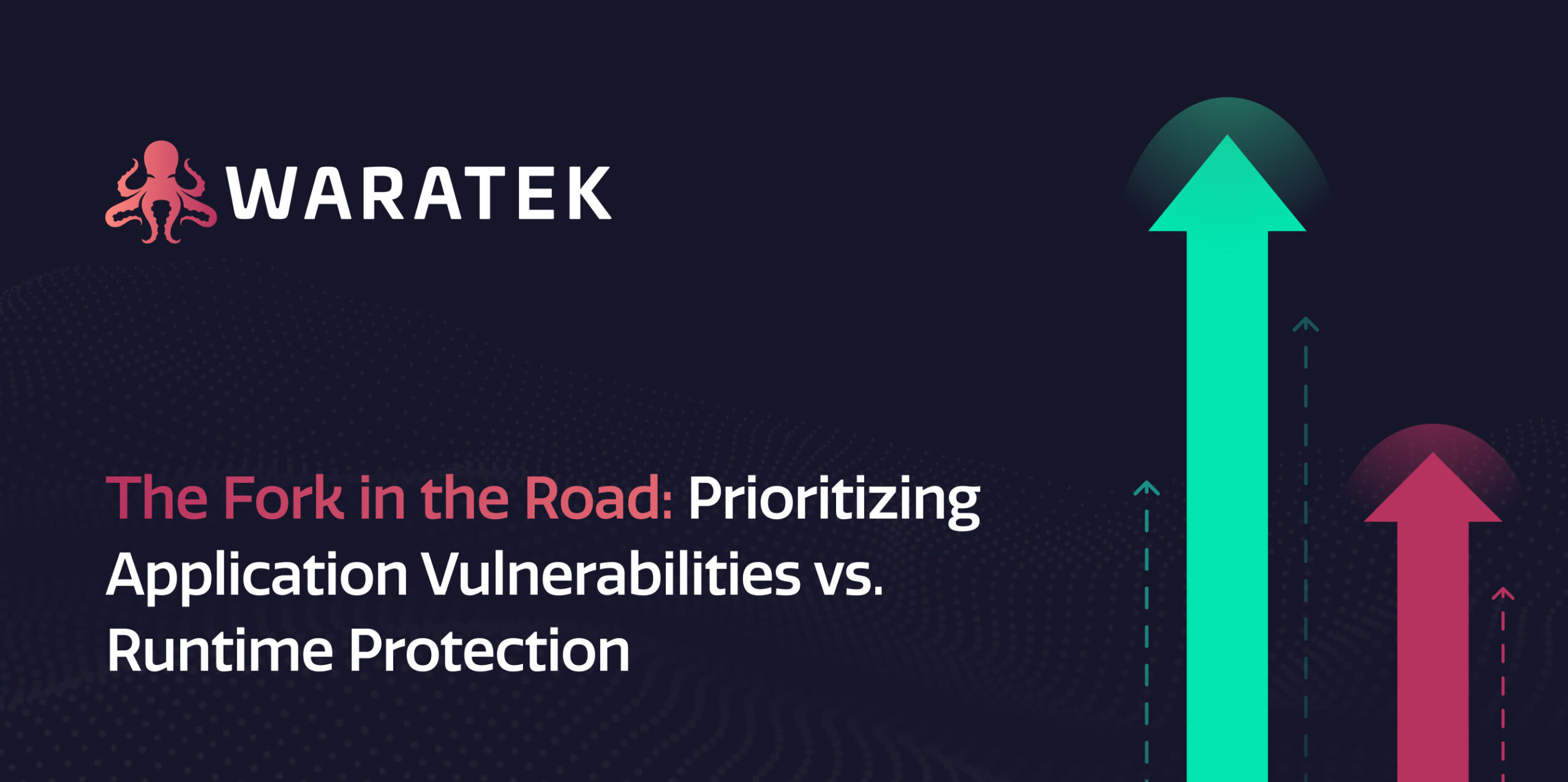There’s good news and bad news; which do you want first? Let’s start with the bad news: cyber threats to applications have been steadily getting more sophisticated. The good news is that application security measures are getting more sophisticated too. But the thing is, the threats and their foils are evolving at a similar rate, meaning the attacks get worse and more numerous even as solutions improve. Between 2022 and 2023, attacks increased by 20 percent despite an increase in spending.
What does this tell us? Traditional defense mechanisms like Web Application Firewalls (WAFs) and Intrusion Detection Systems (IDS) are being out-maneuvered — their improvement and rate of adoption are not enough to keep attackers out. It’s time to rethink how these mechanisms work altogether. By shifting towards more dynamic and intelligent security solutions, we can take a massive leap in our defensive solutions and outpace the evolution of cyber threats.
Enter Waratek’s “tainting engine,” our innovative approach to tracking and sanitizing untrusted data inputs, a common entry point for many cyber attacks. Let’s take a look at how you can leverage Waratek to plug the gaps left where current solutions fall short.
Current Tools Aren’t Cutting It
Organizations today face an array of cyber threats, from Cross-Site Scripting (XSS) to SQL injections, that exploit vulnerabilities in the processing of untrusted data. The traditional defense strategy has been to identify and mitigate these threats post-entry, a method that is increasingly proving inadequate against the sophisticated attacks currently being deployed.
SAST and DAST Scanners, WAFs and IDS Systems are prime examples of tools that operate on this principle. These tools detect attacks as they occur or after they have breached the initial layers of defense. They monitor network traffic and application behavior for patterns that match known attack signatures and input validation libraries. Once an attack is detected, these systems attempt to mitigate the threat by blocking the malicious traffic or alerting administrators to the intrusion.
In theory, that’s exactly what a good security measure should do. But in practice, these tools suffer from significant limitations:
- Evolving Attack Techniques: Cyber attackers continually evolve their methods to bypass traditional detection mechanisms. Polymorphic malware, sophisticated phishing campaigns, and advanced persistent threats (APTs) can often evade signature-based detection systems until it’s too late.
- Late Detection: By the time a breach is detected, the damage may already be done. Sensitive data could be exfiltrated, systems compromised, or malicious payloads delivered and activated. The time window between breach and detection is critical, and in many cases, traditional defenses widen this gap.
- False Positives/Negatives: The reliance on known attack signatures can result in high rates of false positives, where legitimate traffic is mistakenly blocked, and false negatives, where actual attacks are not detected. This disrupts business operations and undermines the effectiveness of security measures.
- Lack of Contextual Awareness: Traditional defenses often lack the contextual understanding necessary to differentiate between benign and malicious use of similar patterns in data or behavior.
- Considerable Performance Overhead: The process of inspecting and analyzing each packet of data in real-time or near-real-time can consume substantial computational resources. The performance penalty can lead to slower response times for legitimate users and may even impact the overall user experience.
- Struggle with Scalability: As organizations grow and their digital ecosystems expand, the volume of traffic and the number of endpoints requiring protection multiply. Meanwhile, the administrative overhead of updating and maintaining signature databases or configuring rules to adapt to evolving network architectures can become prohibitive.
Reliance on these technologies can have real consequences. Security breaches not only lead to financial losses and data theft but also to severe reputational damage and regulatory penalties. The reactive nature of these tools means that they often fail to stop attacks before they cause harm, leading to situations where the security measures in place are equivalent to closing the barn door after the horse has bolted. This presents a need for a more proactive, dynamic approach to security, particularly one that can preemptively neutralize threats by ensuring the safe handling of untrusted data before it can be used to exploit vulnerabilities.
The Tainting Engine In Action
At Waratek, we’ve developed a java application security platform that is designed to prevent any malicious code from being executed in the application. We’re able to do this using a unique system called a tainting engine. This engine proactively tracks the flow of data through the application, flagging and sanitizing it before it can be used in a potentially harmful way. This approach ensures that only clean, verified data interacts with critical parts of the system, dramatically reducing the risk of exploit.
For example, picture an application designed to handle user-generated content that is stored in a backend database—a common scenario for web applications. Users submit data through a form, which is then processed and inserted into the database for retrieval at a later time. This presents a prime target for SQL injection attacks if the input is not correctly handled.
In traditional security setups, input sanitization often relies on predefined patterns to identify potentially malicious input. An application might use regular expressions to filter out characters or patterns commonly associated with SQL injection, such as:
single quotes (‘), double quotes (“), semicolons (;), and SQL keywords like SELECT, DROP, INSERT or DELETE.
However, the tainting engine immediately tags data entering an application as “untrusted.” This tagging is a form of metadata association, which doesn’t alter the data itself but marks it for tracking. As this data traverses through the application, the engine meticulously monitors its flow, mapping out the data’s journey through the various control flows. This enables the engine to not only track the data but also understand the context in which it is being used. Before it is used in any sensitive operations, like executing a database query, the tainting engine assesses whether the data has undergone appropriate sanitization measures for its specific use case.
Should the engine deduce that the sanitization is insufficient, it will automatically sanitize the data by applying context-specific sanitization techniques. In more aggressive configurations, the engine may block the request entirely to ensure the tainted data isn’t processed. Incidents where tainted data reaches critical points of execution are logged by the engine. These logs are invaluable for security teams for alerting purposes and further analysis, helping refine and bolster the application’s security posture over time.
What’s Under the Hood?
The tainting engine utilizes byte code manipulation to inject additional functionality into Java applications without altering their source code. This is critical for Java programs, which are compiled into byte code and executed on the Java Virtual Machine (JVM). We built our own tools such as ASM and Javassist enable the runtime manipulation of this byte code, allowing the tainting engine to monitor and control the flow of data within the application.
The tainting engine operates by maintaining a data ledger that records the lifecycle of data within the application. The data is tracked from its original, untrusted state through every transformation it undergoes. This ledger is crucial for accurately tracing how data is manipulated over time, ensuring that any changes—whether they be through function calls or other processes—are tracked meticulously. By deploying as an agent within the runtime environment, the engine gains the necessary access to intercept and inspect bytecode at runtime. This capability is leveraged to wrap data manipulations with logging and tracking code, ensuring a comprehensive audit trail of data transformations..
Proactive, Efficient, and Compliant
This context-aware oversight significantly reduces the occurrence of false positives. The tainting engine can make more nuanced decisions about what constitutes a threat, minimizing unnecessary disruptions to legitimate application traffic. Furthermore, the design of the tainting engine emphasizes scalability and efficiency, ensuring that its integration into existing systems does not impose a significant performance overhead.
Additionally, by ensuring that only properly sanitized data is processed and stored, the tainting engine aids organizations in complying with stringent data protection standards, thereby safeguarding sensitive information and helping to maintain regulatory compliance.
Get Started
The tainting engine is designed to integrate into an application’s ecosystem with minimal disruption. Setup is as easy as pasting a line of code into your desired application’s source code. Once deployed, the engine operates with optimized data processing algorithms to ensure minimal performance overhead. It runs transparently to end-users while proactively monitoring and sanitizing data so you can get back to what matters most: the product.




